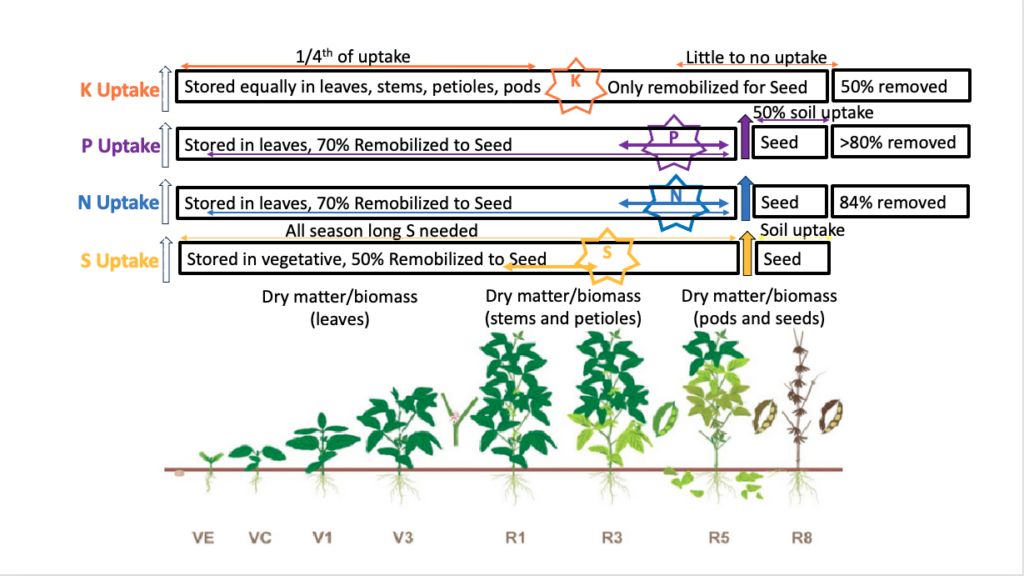In 2014 and 2015, models were built from studies at the University of Wisconsin-Madison and University of Minnesota by way of planting various soybean maturities (RM 1.0 – 2.5) at two different planting dates with a yield range of 40 to 100 bushels. The soybean plants were sampled at different growth stages and partitioned into different parts of the plants (stems, petioles, leaves, pods, seeds, fallen leaves and petioles). All of this hard work was done to help farmers and ag industry and compiled into this document – Understanding Nutrient Requirements and Utilization for High Yielding Soybeans.
This publication provides a summary of soybean uptake and partitioning of macro (N,P,K), secondary (S, Ca, Mg), and micro (Zn, Mn, Cu, Fe, and B) nutrients throughout the growing season. All these elements are needed for soybean growth and development. There is so much information in this study that can help us to better understand and monitor soybean utilization during the growing season such as total nutrient uptake, uptake rate, and partitioning to help guide and evaluate fertility decisions. Biomass (dry matter) accumulation can also provide insight into soybean growth and development.
The models for the N, P, K, and S were constructed at three different yield levels and the key is, as soybean yields increase, so do your crop nutrient needs. For field day purposes, I attempted to sketch out some of the key take aways from this publication.
Dry Matter or Biomass
- Vegetative growth stages are when dry matter and biomass mostly accumulate in the leaves.
- The R1 growth stage is when dry matter and biomass switches over and goes to the stems and petioles.
- It’s not until the beginning seed or after R5 when dry matter accumulates in the pods and seeds.
- The greatest amount of dry matter or biomass accumulation is taking place now during growth stages R4 – R8 as the soybean produces seed.
Nitrogen (N)
- The reproduction stages are when most nitrogen uptake occurs, with the peak being around the R3 and R5 growth stages. High yielding soybeans have greater nitrogen uptake rates over the entire growing season with much higher rates when the seed is developing (R5 and later).
- Large amounts of nitrogen are stored in leaf tissue until between R5 and R6 growth stage and then 70% of all stored nitrogen is redirected to the seed.
- Nitrogen uptake after R5.5 goes directly to the seed. Higher yielding soybeans take up 84% or more of nitrogen and this is removed in the seed. This nitrogen will not return to the soil for the next crop, which demonstrates the soybean plant’s excellent nitrogen use efficiency.
Phosphorus (P)
- Most of the P uptake occurs during the reproductive growth stages and peaks between R3 and R4 growth stages. High yielding soybeans also have a higher phosphorus uptake rate that occurs throughout the growing season.
- Most of the P is stored in the leaf tissue until the R5.5 growth stage and then almost 70 percent of all stored P is remobilized to the seed. All uptake after R5.5 goes directly to the seed.
- About 50% of the P used by the plant comes from the soil after the R5 growth stage.
- Over 80% of the P used by the plant will be removed from the field with the grain during harvest.
- It is imperative to soil test, apply, and maintain adequate soil P levels for proper seed development and to replenish the P for the next crop rotation and to achieve desired crop yields.
Potassium (K)
- Almost ¼ of K uptake takes place before the R1 growth stage, with it peaking after R2, and complete by R5.5 (depending on actual leave levels). This is why it is essential that soil K levels are adequate prior to planting.
- K is stored equally among leaves, stems, petioles, and pod tissue.
- K needed after R5 for seed development is mostly remobilized from the vegetative tissue reserves with slight continued soil uptake.
- Around half of the K uptake stays in the vegetative structures, which remains in the field after harvest as stover. If the stover remains in the field, that K has the potential to return to the soil for future crops.
Sulfur (S)
- Most S uptake occurs after R1 (flower) with peak uptake occurring around R3.
- The total S uptake after R5 will depend on actual yield levels with more needed for higher yields.
- S is stored in vegetative structures until development of the seed, then about half of the stored S goes to the seed, while additional S continues to be taken up from the soil for the seed.
- S needs to be available the entire growing season for seed development.
Continue to dive more into Understanding Nutrient Requirements and Utilization for High Yielding Soybeans to learn more about uptake and partitioning of additional secondary nutrients and micronutrients.





 and then
and then